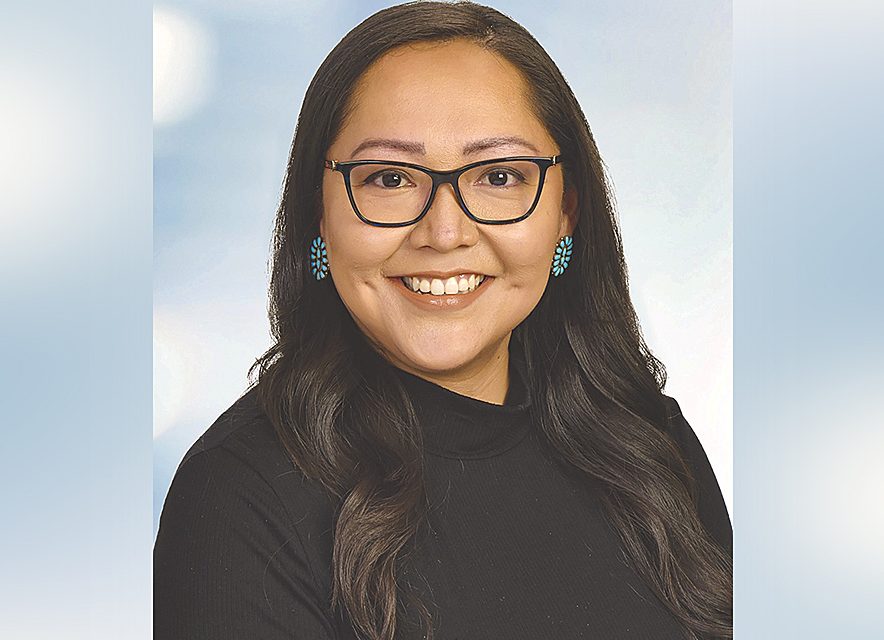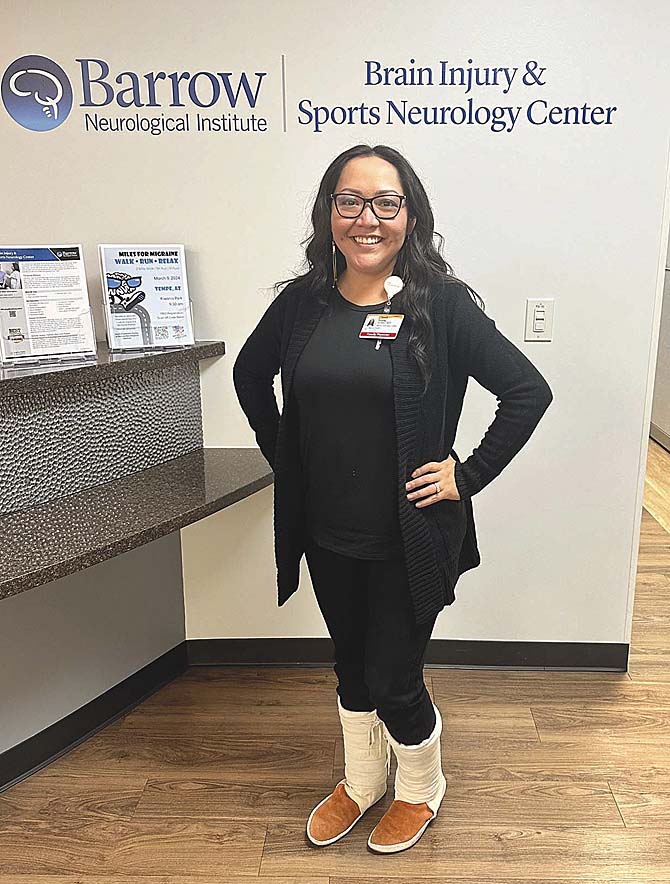
Elevating neurological care: Diné female sports neurologist bringing light to brain health

Courtesy | Barrow Neurological Institute
Diné Dr. Yvette Brown-Shirley is a sports neurologist. She plans on implementing standard testing of concussion education for schools in Native communities that halt neurological care in high schools in Native communities in the state of Arizona. She hopes to elevate care for overlooked communities and schools.
TWIN LAKES, N.M. – After a combined 16 years of dedication to becoming a medical doctor, Dr. Yvette Brown-Shirley is believed to be the first and only Native female sports neurologist to support and prevent neurological health inequities in tribal communities in Arizona.
Brown-Shirley is a neurologist at the Barrow Neurological Institute’s Brain Injury and Sports Neurology Center in Phoenix, where she plans to implement concussion screenings and protocols for schools in Native communities in Arizona.
“There are only two Native American neurologists in Arizona,” Brown-Shirley said.
“I have a unique opportunity with my institution as the director of the Barrow Native American Health Equity Initiative,” she said, as her focus would elevate the neurological care of Native Americans and bring light to brain health, and this opportunity allows that.
Tódích’íi’nii strong
A lifelong resident of Flagstaff, Brown-Shirley is an assistant professor in the Department of Neurology at Barrow Neurological Institute in Phoenix. Brown-Shirley is Tódích’íi’nii and born for Mą’ii Deeshgiizhnii. Her maternal grandfather is Tó’aheedlíinii, and her paternal grandfather is Táchii’nii. Her parents are Raelene Anderson and Wilfred Brown Jr. from Sawmill and Ganado, Arizona.

Courtesy | Barrow Neurological Institute
As a neurologist in the Brain Injury and Sports Neurology Center, the Diné-born and raised Flagstaff resident, Dr. Yvette Brown-Shirley, is an assistant professor in the Department of Neurology at Barrow Neurological Institute in Phoenix.
As high school sports are popular across Arizona, especially in the Navajo Nation and other Native communities, student-athletes often don’t have access to neurological care in their schools or communities, resulting in a bias that exists throughout tribal communities.
As a student-athlete in 2005 while at Coconino High School in Flagstaff, where she graduated and played volleyball, Brown-Shirley said she had not experienced a concussion herself but witnessed students hitting their heads and were told to “shake it off and keep playing.” During this time, she said no laws involving concussions were known to protect student-athletes.
Nowadays, those words would not hold up. “Times have evolved and changed, so now each state has concussion laws to follow to get our athletes back safely into their sports,” Brown-Shirley said.
Concussion education, athletic trainers in Nation
Standard screenings are available from the Arizona Interscholastic Association, which recommends them to schools across the state. Some schools require their student-athletes to partake in concussion education at least once to be aware of symptoms regarding concussion. However, it depends on the location of tribal schools and if concussion resources are available.
According to Brown-Shirley, only two schools in the Navajo Nation have an athletic trainer: Jalen Claw at Monument Valley High School and Muriel Tsosie at Window Rock High School. This could be a concern as many American Indian/Alaska Native children and adults have higher rates of traumatic brain injury-related hospitalizations and deaths than any other racial and ethnic group, according to the Centers for Disease Control and Prevention.
Therefore, Brown-Shirley would like to ensure that student-athletes’ brain health is essential as she has seen many brain-related injuries in all ages from high school, college, and professional sports.
Family instillment
As a field of medicine that studies disorders of the brain, spine, and nerves, it follows expectations and responsibilities; however, Brown-Shirley could not have pursued a career without the support and encouragement from her family.
Education was a priority for Brown-Shirley’s family, especially when her late grandmother Marian Anderson earned a master’s degree and was a middle school teacher. That alone had always been a pivotal role model for her and the family.
“I drew a lot of my strength and purpose from my family, culture, and community,” said Brown-Shirley, whose maternal grandparents are the late Marian and Raymond Anderson, and her paternal grandparents are Minnie Brown and the late Wilfred Brown Sr.
“I first became interested in neurology because of my early experience with a family member experiencing seizures,” Brown-Shirley said. “He (nephew) ended up having epilepsy surgery to remove the part of his brain that was causing the seizures,” which resulted in Brown-Shirley being fascinated with the field of medicine.
However, seeing many traumatic brain injuries daily weighs heavily on Brown-Shirley as she addresses the health disparities Native communities face. She is the only advocate for many of these people and provides direly needed care. She considers her position a blessing because her years of education, residencies, and fellowships are needed in Native communities.
Blessed stethoscope
Leading by example in a field that encounters many patients across the state, Brown-Shirley wears daily a beaded and blessed stethoscope that was gifted to her by her grandfather when she received her medical degree and certificate of public health from the University of New Mexico School of Medicine in Albuquerque in 2015.
“I’ve always been taught to be proud of who I am and where I come from,” Brown-Shirley said. Therefore, she thanks Barrow for supporting and allowing her the time and space to do these outreaches, connect with tribal leaders, and create change.
Breaking barriers has led Brown-Shirley to serve as an unaffiliated neurotrauma consultant for the NFL, work with high school athletes, and serve as a sideline concussion observer for Arizona State University athletics.
“It’s been nice to reach the elite level of providing sports neurology and neurological care at that level,” Brown-Shirley said. “It’s a journey in itself.”
Being attentive in brain care
After completing her residency in 2020 at Barrow Neurological Institute at Phoenix Children’s Hospital child neurology, Brown-Shirley accepted a fellowship in 2021 at Barrow Neurological Institute at Dignity Health at St. Joseph’s Hospital and Medical Center in sports neurology and traumatic brain injury. Now, serving as the clinical director of the Native American Health Equity Initiative at Barrow, she aims to elevate care for the people.
Often, Brown-Shirley said people do not realize they have a concussion, which enables room for guidance and growth to serve people with various traumatic brain injuries better. Most of the time, people do not receive care regarding a concussion or a brain injury.
“With these complex cases, it could involve multiple disciplines in trying to help these people in their most vulnerable times of need, and their families, too,” said Brown-Shirley.
“In the brain itself, it is so fascinating, I could keep learning about the brain,” Brown-Shirley said. “As it (brain) evolves over time, we are still learning new things about brain health.”
Essentially, neurologist studies the brain and the spinal cord, as well as how injuries and diseases affect the brain and spine. Although neurologists are only responsible for a small number of diseases and disorders, Brown-Shirley said the brain is complex, and her work is geared toward traumatic brain injuries involving concussions, whether sports or non-sports related.
Creating a pathway
Brown-Shirley’s position is unique due to her background and experience. She has seen many patients with various traumatic brain injury accidents, and she goes above and beyond to create a treatment and recovery plan for them.
“It’s very much individualized and their experience at that time,” said Brown-Shirley, as each concussion or brain injury is different. Therefore, a treatment plan is custom-made to serve their needs best.
Heavy contact sports like football, lacrosse, soccer, basketball, and boxing and non-sports like motor vehicle accidents and falls involving children and elders significantly impact the brain.
According to Brown-Shirley, common symptoms of head trauma or head injury are headache, dizziness, balance, nausea, light or sound sensitivity, concentration/focus issues, and memory loss that occurs after a hit to the head.
In a sports setting, athletic trainers are needed to evaluate the athlete to prevent another head injury when experiencing symptoms. Initial recovery is usually two to four weeks, depending on the person’s age. However, four weeks is recommended. If symptoms worsen and last longer than usual, request a referral to a specialist for an evaluation.
Tackling a considerable responsibility, Brown-Shirley said there is a need for more people in these positions of power to produce for our youth to rise and create a pathway to serving the Native communities.
“It’s so important,” Brown-Shirley said. “Seeing Native people being so successful, especially Native youth seeing us.”








 Highway 264,
Highway 264, I-40, WB @ Winslow
I-40, WB @ Winslow